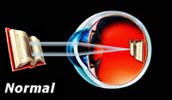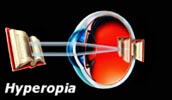|
The name
"LASIK" is short for Laser In-situ Keratomileusis. LASIK is
used to treat low to high amounts of nearsightedness, astigmatism,
and farsightedness. LASIK combines the computer controlled
precision of the Excimer Laser with the benefits of another
type of refractive surgery called Lamellar Keratoplasty (a
procedure where an instrument known as a microkeratome makes
a small flap in the outer layer of the cornea).
Hyperopia

Normal
vision - to see clearly, light rays are focused on the retina
by both the cornea and the lens of the eye. In a hyperopic
eye, commonly referred to as "farsighted" (place
cursor over image), light rays from objects are
focused in back of the retina causing images - at a distance
and close up - to be blurred.
|
|
A
thin corneal flap is created using a special instrument
called a microkeratome |
|
|
The
Excimer laser pulse, after being preprogrammed for the
appropriate hyperopic correction, is applied to the corneal
bed. |
|
|
The
"flap" is returned to its original position of a quick,
natural recovery. |
|
|
Following
LASIK treatment for farsightedness, the curvature of your
central cornea is steeper. Light rays from viewed objects
are focused on the retina. |
Result
After LASIK Surgery For Hyperopia

Before
LASIK treatment for farsightedness, light rays from viewed
objects are focused behind the retina. After the LASIK treatment,
the "steeper" cornea allows light rays to bend in such a way
as to become focused on the retina.
Over
96% of patients treated with the LASIK procedure at the Sunetra
Eye Centre are no longer required to wear their glasses or
contacts. However, individual results cannot be guaranteed.
|

